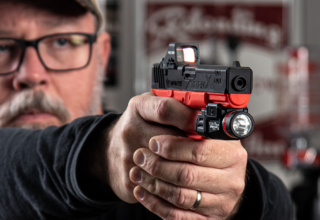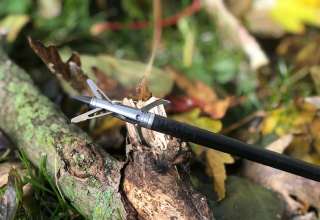Bowhunting is more than a pastime for me, it’s my life obsession. I approach every bowhunt as a specialist – setting up different outfits to meet specific needs; from fast, flat-shooting rigs for long-range game, to high-energy setups for the largest big game. Yet I understand not everyone can afford more than one bow decked out with various accessories. I understand not wanting to interchange various components and re-tune a single bow between big hunts. I also understand there’s a ring of truth to the old saying “Beware of the man with only one gun (or bow).” There’s certainly much to be gained by becoming intimately familiar with a single bow-and-arrow combination. For that reason alone, most bowhunters need only a single arrow.
The Compromise
Is it realistic to expect a single arrow to do it all; an arrow light and fast enough for long-range pronghorn, quiet enough for string-jumping whitetails, heavy enough to provide confidence on a formidable bull elk? Obviously many bowhunters do just that.
The do-all arrow isn’t so light as to cause excessive bow noise or hinder penetration and not so heavy as to create looping trajectory. This is somewhat subjective, but for the sake of hard numbers, let’s say an ideal middle-ground compromise weighs 9.5 grains per inch (gpi), give or take a few grains. These numbers apply to average adult males shooting around 65 pounds at 29 inches (65#@29”)–the national average—give or take 5 pounds and an inch of draw length. Luckily the industry understands the need for do-it-all arrows, offering a plethora of options.
How Broadhead Choice Weighs In
 First, it’s important to understand how broadhead design factors into this. Obviously not all broadheads are created equal, and this directly relates to terminal performance. For instance, while aggressive mechanical broadheads cutting 1 ½-plus inches will work fine on thin-hided, light-boned game at long range, or average white-tailed deer taken at short ranges, this wouldn’t make an ideal choice for big bears, elk or moose.
First, it’s important to understand how broadhead design factors into this. Obviously not all broadheads are created equal, and this directly relates to terminal performance. For instance, while aggressive mechanical broadheads cutting 1 ½-plus inches will work fine on thin-hided, light-boned game at long range, or average white-tailed deer taken at short ranges, this wouldn’t make an ideal choice for big bears, elk or moose.
I tend to think in terms of worst case scenario (shoulder blades or facing-away shots resulting from string-jumping, spinning game), so my general rule of thumb—especially when using down-the-middle shafts—is limiting the use of wide-cutting mechanicals to light-framed big game at longer ranges, or whitetails from treestand ranges. Choosing a solid replaceable-blade, faceted-tipped, fixed blade heads for black bears, burley northern whitetails or mule deer; true cut-on-contact designs for the largest game. This doesn’t imply a quality mechanical won’t get the job done on the largest game, it’s just that rugged cut-on-contacts save your rear if something goes wrong—like a shoulder-blade hit.
Middle-Ground Options
 There are plenty of options for the single-arrow bowhunter – Beman revolves around this shaft class. For long-range shots where pin-point accuracy is paramount, the ICS Precision Hunter posts confidence-boosting .001-inch straightness tolerances in a shaft weighing 9.3 gpi in 340 spine. The ICS Hunter Classic and Bow Hunter offer identical weight with .003- and .005-inch straightness tolerances, respectively. The .003-inch-straight ICS White Out weighs slightly less, at 8.8 gpi in 340, with head-to-toe white finish making it easier to read blood left on the shaft after a hit and to take appropriate actions. The ICS Hunter Realtree replaces white finish with Realtree camouflage, also wearing an 8-grain MicroLite S Nock (all others hold 13-grain Super Nock, all options including 21-grain CB aluminum insert). Beman “White Box” arrows come preassembled and cut to 29.5 inches, ready to shoot out of the box, with mass mirroring other ICS offerings.
There are plenty of options for the single-arrow bowhunter – Beman revolves around this shaft class. For long-range shots where pin-point accuracy is paramount, the ICS Precision Hunter posts confidence-boosting .001-inch straightness tolerances in a shaft weighing 9.3 gpi in 340 spine. The ICS Hunter Classic and Bow Hunter offer identical weight with .003- and .005-inch straightness tolerances, respectively. The .003-inch-straight ICS White Out weighs slightly less, at 8.8 gpi in 340, with head-to-toe white finish making it easier to read blood left on the shaft after a hit and to take appropriate actions. The ICS Hunter Realtree replaces white finish with Realtree camouflage, also wearing an 8-grain MicroLite S Nock (all others hold 13-grain Super Nock, all options including 21-grain CB aluminum insert). Beman “White Box” arrows come preassembled and cut to 29.5 inches, ready to shoot out of the box, with mass mirroring other ICS offerings.
All these models provide ideal middle-ground mass—light enough to offer flattened trajectory, heavy enough to efficiently absorb a bow’s released energy for quieter shots and ample penetration on the largest animals.
- Gaining an Edge With Sharp Broadheads - November 17, 2017
- Using Scents to Create Higher-Odds Bow Shots - November 7, 2017
- Fundamental Crossbow Maintenance - October 25, 2017















